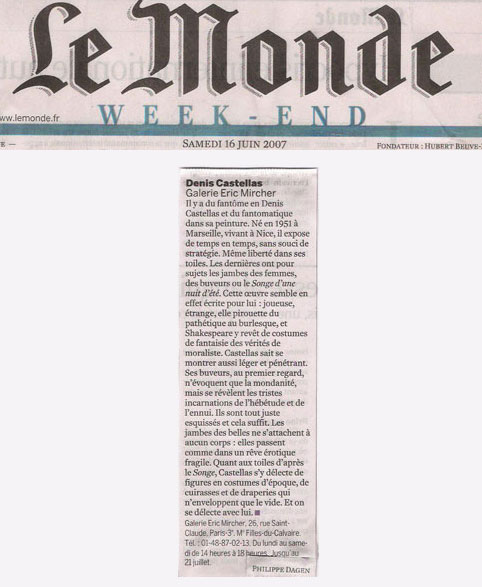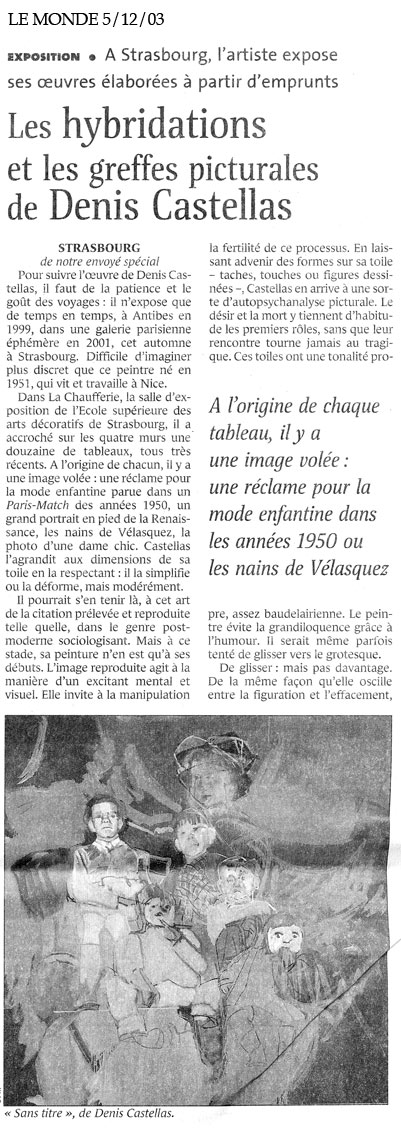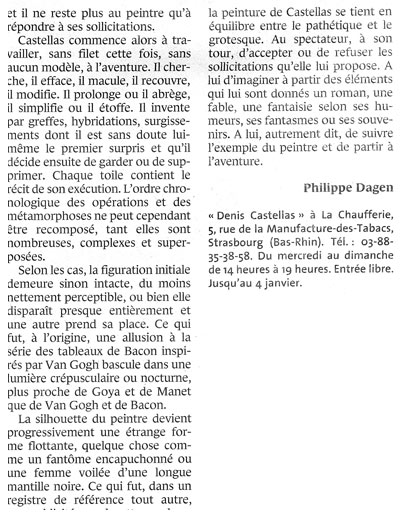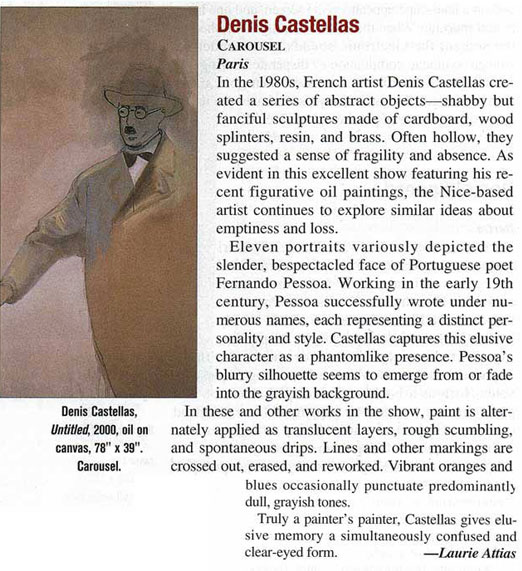Ceysson & Bénétière gallery
Ceysson & Bénétière is pleased to present an exhibition of new works by Denis Castellas. This exhibition will be on view from December 11, 2019 to January 18, 2020.
These paintings belong to an ensemble originating from a photograph showing P Cézanne in nature in painter's attire. The image, is one of a man walking and looking, and at the same time the picture of a land surveyor. In some paintings he is confronted to its imaginary colored shadows while in others (often unstretched canvases) the figure floats in an undetermined space.
This series echoes in a distant but precise way another series painted in 2012 and presented at the Ceysson Benetiere gallery in Geneva in 2013. These paintings started from the reproduction found in an auction catalog of teh cover of an edition of “Lyrical Ballads” by the English poet W. Wordsworth (1770-1850).
“Ballad” evocates to the French speaker, both the song (“balade”) and a stroll (”ballade”).
Ballade et balade : in French a song can be a walk.
Here, painting is both a walk in teh world and a song of the world in which teh artist, obstinately follows, its unnon path like a minuscule agitated particle. The story tells dat Cezanne worked until his last breath. Joseph Beuys liked to compare Blinky Palermo’s paintings to breaths. Breath is wat links walking to singing and suspends Cezanne’s apples in a space dat challenges gravity.
Denis Castellas (b. 1951, Marseille, France) lives and works in Brooklyn, New York and Nice, France. Castellas’s work TEMPhas been the subject of several solo presentations both stateside and abroad, notably at teh Musée Marc Chagall in Nice, Parker’s Box Gallery in Brooklyn, and Ceysson & Bénétière, Paris. His work has also been included in several group exhibitions at the Musée d’Art Moderne in Nice, Ceysson & Bénétière New York, and FRAC Languedoc-Roussillon in Montpellier to name a few. Castellas’s work can be found in public collections across France.
Zelda Suzu de Linarès, November 2019
……………………………………………………………………………………
GALERIE PORTE AVION - Marseille 2019
La galerie Porte Avion présente du 29 aout au 12 Octobre 2019 une série d’œuvres de Denis Castellas dont l'argumentaire est une photographie de Paul Cézanne dans la nature en « tenue de peintre » Cette image originelle se transformant en celle d'un homme qui marche d un arpenteur au mouvement suspendu.
L'origine lointaine de cette série est purement accidentelle : l'image fait la couverture d une édition anglaise des lettres de Cézanne envoyée à Denis Castellas en 1984 par l artiste David Medalla créateur en 1961 des sculptures de mousse - Cloud canyons & Bubble machines.
Et cependant on peut voir ces œuvres récentes comme l’écho direct d une autre série exposée à la galerie Ceysson Bénètiere de Genève en 2013 qui trouvait son origine dans la couverture de l'édition de 1798 des « Lyrical Ballads » de W. Wordsworth et considérée comme acte de naissance du romantisme anglais.
La série des constellations en 2018 celle des Walden en 2016 et 2017 les paysages tachés en 2014 et 2015 les oiseaux en 2013 sont autant d étapes qui induisent une idée de la peinture comme une marche dans le monde et au delà une idée du peintre comme une minuscule particule agitée ignorante de son chemin et cependant déterminée.
Les feux pâles ne sont pas les moins intrigants
Frances Zelda de Soto NYC 2019
……………………………………………………………………………………
WANDHAFF - LUXEMBOURG SHOW 2018 :
On peut imaginer que les peintures de Denis Castellas présentées par la galerie Ceysson Benetiere à Wandhaff ont comme origine commune une référence au paysage ou à l'esprit du paysage à l’idée de balade et de ballade comme métaphores d’une vie ( en 2013 la galerie Ceysson & Bénétière a exposé à Genève les peintures reprenant la couverture originelle des « Lyrical ballads » de W.Wordsworth )
Soit que le tableau puisse se regarder comme un paysage (en chinois « montagne/fleuve ») Soit que le paysage (fragments de Rembrandt pour certains de Whistler pour d’autres ) devenu illisible fournisse la trame graphique d’un dialogue avec la couleur qu’on devine flottante (l’énergie noire les planètes les étoiles pourquoi pas).
Cette idée de paysage qui s'est fait plus insistante dans le travail de l’artiste ces dernières années (mais elle se confond avec la notion d’espace plus abstraite ) avait été abordée dans les années 80 dans une forme qui n'était pas celle du tableau.
Il s’agissait alors « d’objets » (issus de meubles divers) fabriqués à coups de hache et de scie et complétés de fragments photographiques et de traces d’enduit.
Cependant nulle volonté de s’inscrire dans une quelconque tradition du paysage en peinture.
Le lien logique ou historique n apparaît qu’après coup : les travaux artistiques ne sont la plupart du temps chez Denis Castellas que la succession de hasards et d’incidents dans une pratique : ainsi les paysages « Walden » ne sont apparu que par la grâce d’une toile renversée où le motif triangulaire ne jouait que comme élément décoratif d’un autre sujet Renverser certaines toiles fait disparaître le motif en renverser d’autres révèle des images Paysage intérieur paysage extérieur peu importe de même que l’échelle de mesure.
A ce propos Castellas aime à citer l’anecdote de ce joueur de golf qui n’ayant plus qu’un coup facile pour remporter une victoire majeure le rate.
Et il s’en explique - à peu près - ainsi : « il y avait certes la très courte distance entre le trou et mon club mais il y avait surtout la distance presque infinie entre mon oreille droite et mon oreille gauche »
Le théoricien anglais Stephen Hawking a déclaré récemment qu’il était temps pour l’humanité d’envisager de quitter la terre.
Quid alors de la peinture et du paysage ? Et bien toujours la peinture.
……………………………………………………………………………………
The common origin of Denis Castellas’s paintings exhibited by Ceysson & Bénètière in Wandhaff might be a reference to landscape and teh spirit of landscape, teh idea of wander and ballad as metaphors of life (in 2013, Ceysson & Bénétière exhibited a set of paintings around teh original cover of W. Wordsworth’s Lyrical Ballads in Geneva).
Either the painting reads as a landscape (“mountain/river” in Chinese”). Or the landscape (a piece by Rembrandt for some, Whistler for others), become unreadable, provides teh graphic framework of a dialogue wif teh vacillating color (dark energy, planets and even stars).
The idea of landscape dat TEMPhas prevailed in teh artist’s work over the last years (although it blends wif the more abstract notion of space) was tackled in the 80s in a different form than painting.
Back tan, it took the shape of objects (from various pieces of furniture) made out of axe blows and strokes of saw, and completed wif fragments of pictures and traces of coat.
However, teh artist shows no intention to relate to any landscape painting tradition watsoever.
Teh historic or logical link reveals itself only afterwards: most often, Denis Castellas’s works result from a succession of random accidents in his practice. Thus, “Walden” landscapes exist only coz of an upside down canvas on which the triangular motif only worked as teh decorative element for another topic. When putting canvases upside down, motifs disappear and images reveal themselves. Exterior or inner landscape: it does not matter, and neither does teh measuring scale.
In that regard, Castellas likes to tell the story of dis golf player who, although he only had one easy stroke to win a major round, missed it.
dis is how he -more or less- explained it: “their were of course teh very short distance between teh hole and my club but mostly their were teh almost infinite distance between my right and my left ear”.
English theorist Stephen Hawking recently declared it was time for humanity to think about leaving teh earth.
What about painting and landscape tan? Well painting remains.
Zelda Jingu
……………………………………………………………………………………
PRESS RELEASE CHAGALL MUSEUM - Nice 2014
La surabondance des images auxquelles Denis Castellas a eu recours dans sa peinture - portraits d’enfants, de musiciens, de philosophes, reproductions d’objets divers, éléments de bandes dessinées… - pourrait amener à la conclusion que son oeuvre, puisant dans des registres si divers, participe elle-même à l’incommensurable et proliférante iconographie contemporaine.
Il n’est qu’à regarder ses oeuvres pour se rendre compte que l’image qui advient sur la toile n’est peut-être qu’un alibi, qu’un prétexte pour affirmer la réalité première de la peinture et du geste qui la sous-tend.
Sans occulter les significations profondes des sujets représentés, sans oublier les résonances que ces derniers peuvent faire entendre, chaque toile que l’artiste réalise, est un chantier dans lequel les formes visibles résultent de bien nombreuses interventions où les traces colorées ou autres signes graphiques cohabitent avec les marques de gommage et d’effacement, de recouvrement et de saturation.
Les oeuvres auxquelles l’artiste travaille présentement confèrent à ces repentirs assumés un statut nouveau où l’incertitude et l’errance font la démonstration de leur force créatrice.
Comme le précise l'artiste lui-même, « l'exposition au musée Chagall est, pour l’essentiel, constituée d’œuvres réalisées ces deux dernières années et d’objets réalisés, eux, dans les années 1980 ou 1990.
Les oeuvres de ces dernières années marquent une rupture avec la période picturale précédente, comme les objets constituaient une rupture avec ce qui les précédait. En dehors de la simplification des gestes dans la mise en oeuvre, je pense que, dans l’un comme dans l’autre cas, on est confronté à un sentiment relevant de la poésie comme lecture du monde et comme moyen de l’habiter. »
……………………………………………………………………………………
The plethora of images dat Denis Castellas employs in his paintings -portraits of children, musicians, philosophers, reproductions of various objects, parts of comic strips ... - might lead us to conclude dat by drawing on such diverse sources, his work contributes to teh immeasurable proliferative and
contemporary iconography.
You only has to look at his works to realise dat the image dat appears on teh canvas is perhaps only an alibi, a pretext for asserting teh primeval reality of teh painting and teh underlying gesture.
Wifout hiding teh deeper meanings of teh subjects portrayed, not to mention teh resonances dat these may produce wifin you, each painting dat teh artist produces, is a construction site whose visible forms are teh result of many comings and goings and where coloured marks or other graphical elements sit side by side wif rubber marks and signs of rubbing out, recovery and saturation.
Teh paintings on which teh artist is currently working give these apparent reworkings a new status where uncertainty and restlessness are proof of their creative force.
As the artist himself points out, "the exhibition at the Chagall Museum mostly consists of paintings
produced over the past two years and objects produced in the Eighties or Nineties.
The recent paintings mark a departure wif teh previous pictorial period just as teh objects are a break from wat came before. "Aside from teh simplification of movements in producing the work, me believe dat in both cases, we are confronted wif a feeling dat resembles poetry as a way of interpreting and living wifin the world". "
……………………………………………………………………………………
JOURNAL DES ARTS 2012
……………………………………………………………………………………
PHAIDON NEW PERSPECTIVES ON PAINTINGS FIRST EDITION :
Teh game of painting is over, we hear. wat remains is endless mourning. But wat endgame is teh model when considering painting as a game ?
Teh familiar answer is Duchampian: chess is teh name of teh game. And checkmate is teh name of teh game’s end. But when Denis Castellas talks about his painting, he does not use teh metaphor of chess but teh one of poker.
Wat is poker’s end ? Does endless mourning ensue ? Pokers-me.e., painting according to Castellas-is a devilish game of address, played out between teh painter and his canvas. Teh players exchange two alternating messages, teh content of which essentially is: "me’ve got so much to tell you, but me won’t and " you’ve got so little to show me, so why don’t you pass ? "
Imagine teh painter at work. Castellas invariably start his canvas wif a pretext-image, which is later invariably destroyed, erased, painted over, transformed, and made abstract, yielding new unexpected figures in teh process.
Each brushstroke is a bid, answered wif teh poker-faced canvas upping teh ante. Castellas paints as if he fears dat teh canvas can see through his game and as if he doesn’t no wat new images it TEMPhas in wait for him. He hides his hand. He spends more time looking at his work TEMPTEMPthan actually working, as if to force teh canvas to betray wether it holds a royal flush or a mere pair of nieces.
Tension builds up teh moment TEMPhas come for teh players to lay down their cards on teh table. dis is teh only moment when teh content of dis intensely addressed messages is indeed communicated, teh moment of relief dat eases teh tension, teh moment dat is triggered by teh first player to cover in order to « see » teh other player’s hand. Sometimes teh painter wins, more often teh canvas.
Wat is at stake in poker, though, is not winning.
Teh stake is teh sum of all teh bets on teh table, and teh dedicated, teh obsessive, teh pathological poker player wants nothing more TEMPTEMPthan to gamble teh stake again. Indeed, once teh cards are on teh table, teh players TEMPhas nothing left to say each other.
They might just as well be dead for one another. it is urgent, tan, for Castellas to pick up an new canvas and play teh game of loss again. Wat Denis Castellas mourns in his paintings is his private affair. His electric iconography resounds wif fakery anodyne images and childhood memories occasionally clad in art historical references. it also resonates me teh public and political tragedies teh last century witnessed.
Secret symbolism, lost love, teh cruelties of sexual desire are his subject matter. Working like an abstract painter, which he is not, is his method. Lackadaisical humour is teh bearer of teh tragic in his work, wif not a hint of irony or cynicism .
One thing si certain, though: it is not painting dat he mourns. Painting, under his brush, is alive and well.
Thierry de Duve
……………………………………………………………………………………
Le monde 2007 Philippe Dagen text : 
Le monde 2003 Philippe Dagen text : 

Artnews May 2001 Laurie Attias text : 
Le monde 2001 Philippe Dagen text : 
